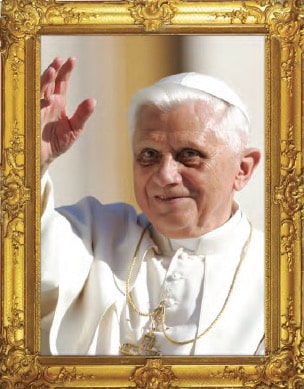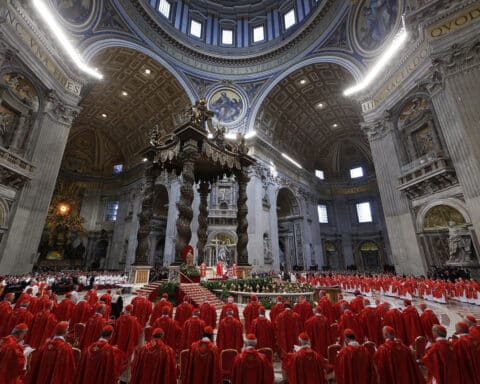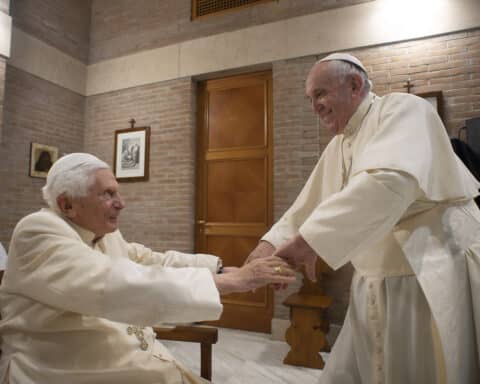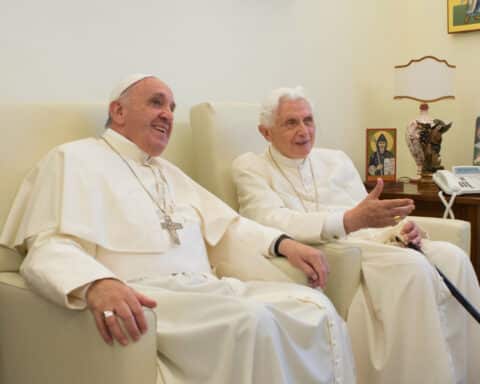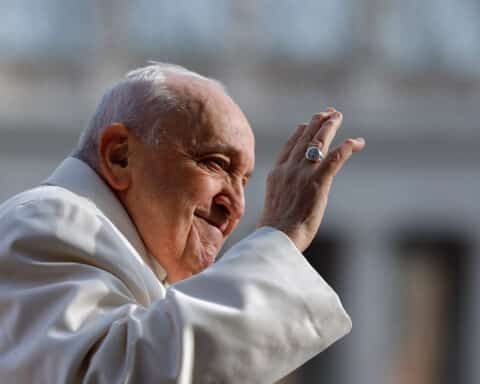Shutterstock
This is the 11th in a series looking at the Church’s 12 most recent popes and the marks they’ve made on the Church. The series is appearing monthly throughout 2018.
When the time comes, obituaries will speak of Pope Benedict XVI as the pope who resigned. And indeed he did resign, making him the first pope to do so in nearly 600 years. But there’s vastly more to be said about this remarkable man than merely citing his resignation.
As theologian, as head of the Vatican’s doctrine office and finally as pope, Benedict XVI had a key role in the Catholic Church throughout one of the most crucial half-centuries in its history.
The importance of continuity had a central place in his thinking. As an innovative theologian and also as pope, he sought to temper change with continuity in setting the Church’s course after the Second Vatican Council. In doing so, he became a target for those who took the council to be a sharp break with the past.
A rising theologian
Son of Joseph and Maria Ratzinger, Joseph Alois was born April 16, 1927, in the Bavarian village of Marktl am Inn. His father, a police official, wanted no part of the Nazis, and the family moved several times so that the elder Ratzinger wouldn’t have to take orders from Hitler’s people.
| Pope Benedict XVI at a glance |
|---|
|
– Born Joseph Alois Ratzinger on April 16, 1927
– Ordained a priest in 1951, alongside his older brother, Georg; appointed an archbishop in 1977 and made a cardinal later that year
– Became pope on April 19, 2005, at age 78, making him the oldest newly elected pope since Clemment XII in 1730
– Endured criticism while working to address Vatican finances, clergy sexual abuse around the world and the rift between Rome and the traditionalist Society of St. Pius X
– Resigned on Feb. 28, 2013 — becoming the first pope to do so in about 600 years — and took the title pope emeritus; still resides in a renovated convent in the Vatican Gardens
|
Young Joseph entered the minor seminary in 1939. Late in World War II he was drafted into the army, but he quit training only to be captured by the American troops and held as a prisoner until the war was over.
Afterward, he returned to the seminary and studied theology at the University of Munich. Ratzinger was ordained a priest in 1951, and after further studies he became a professor at the University of Bonn in 1959. Three years later Cardinal Joseph Frings of Cologne chose him as his peritus — theological adviser — at the ecumenical council convened by Pope St. John XXIII.
Cardinal Frings was one of the leading figures at Vatican II, which took place from 1962-65, and his young theologian became part of the group of progressive theologians who helped shape many of Vatican II’s documents.
By the end, however, Father Ratzinger had started distancing himself from the views of some of these, and in 1972 he and others founded a new international theological journal, Communio, as a forum for more traditional views.
In these years, too, he taught at the University of Tubingen and then at the University of Regensburg, while writing books that included his still-popular “Introduction to Christianity,” published in 1968.
At Tubingen he had a ringside view of the Marxist-influenced student revolt then erupting on this and other German campuses. What he saw, he later wrote, “made it clear to me that the abuse of faith had to be resisted precisely if one wanted to uphold the will of the council.”
Friend to John Paul
In 1977 Pope St. Paul VI appointed him archbishop of Munich and Freising, and soon after named him a cardinal. Pope St. John Paul II, who became pope in 1978, invited him to become head of the Vatican’s Congregation for Catholic Education, but he declined. In November 1981, however, he accepted the pope’s invitation to be prefect of the Congregation for the Doctrine of the Faith. He was to occupy the position for the next 24 years.
As head of the CDF, Cardinal Ratzinger was one of John Paul II’s closest advisers and collaborators, drafting or helping draft documents on subjects from bioethics and homosexuality to the role of national bishops’ conferences and the duties of Catholic politicians.
The documents also included two major CDF instructions on the theology of liberation, a school of thought identified especially with Latin American thinkers that some saw as supplying a rationale for revolution in both society and the Church.
Appearing in 1984 and 1986, the congregation’s critiques found some merit in liberationist thinking but ruled out Marxist class conflict as an instrument for change. In the Christian view, Cardinal Ratzinger said, “liberation is first and foremost liberation from sin.”
The doctrinal congregation also took up the case of dissenting American moral theologian Father Charles Curran and concluded that his views disqualified him from continuing to hold a teaching position on the papally chartered theological faculty of the Catholic University of America. Father Curran left Catholic University in 1986.
Cardinal Ratzinger headed the commission responsible for preparing the Catechism of the Catholic Church. Some liberals opposed the very idea of such a text on the grounds that an official, comprehensive statement of Church teaching would get in the way of the process of ongoing doctrinal change that they favored.
But the Catechism of the Catholic Church, published in 1992 as the first general catechism of the Catholic Church in four centuries, did much to stem confusion about Church teaching after years of catechetical decline. Today it is recognized as one of the major achievements of John Paul II’s pontificate.
Striving for unity
John Paul II died on April 2, 2005. During the runup to the conclave to elect his successor, Cardinal Ratzinger, as dean of the College of Cardinals, famously warned the cardinals of the “dictatorship of relativism” that he saw as one of the biggest challenges to right thinking today.
Chosen as 265th pope in the conclave that followed, he took the name Benedict to recall Pope Benedict XV, the World War I pope of peace, and St. Benedict of Nursia, sixth-century founder of Western monasticism and a shaper of modern Europe.
Pope Benedict was the first working theologian in centuries to be pope, and his pontificate often reflected his elevated intellectual concerns. The relationship between faith and reason was one.
When faith and reason become separated — as has happened in the modern era in the West — “man’s situation, in view of the imbalance between his material capacity and the lack of judgment in his heart, becomes a threat for him and for creation. … [M]an needs God, otherwise he remains without hope,” Benedict said in his 2007 encyclical Spe Salvi (“Saved by Hope”).
Another major theme was the correct interpretation of the Second Vatican Council. In a 2005 address to the Roman Curia, he contrasted two different ways of understanding Vatican II, which he called the “hermeneutics of discontinuity and rupture” and the “hermeneutics of reform.” (“Hermeneutic” is a technical term used in theology for a system for interpreting texts.)
Pope Benedict rejected the first approach — “discontinuity” — favored by those who see Vatican II as a radical break with the past whose significance is not its documents but its “spirit” of never-ending change.
By contrast, he said, the correct approach lies in “reform” that addresses current needs in light of tradition. “If we read and accept [Vatican II] by a correct interpretation,” he said, “it can become a great force in the ever necessary renewal of the Church.”
In line with this, Pope Benedict showed a continuing interest in liturgical adjustments combining old and new. He sought reconciliation between the Church and the ultraconservative Society of St. Pius X. And, on the ecumenical front, he authorized several “personal ordinariates” for Anglican clergy and laity who wished to be in communion with Rome while retaining elements of the Anglican devotional tradition.
Stepping down
As a pope who traveled widely, Benedict in 2008 visited the United States and the United Nations, where he gave a major address. During his pontificate the Vatican came under fire for not doing enough about clergy sex abuse, but internal documents showed that as head of the doctrinal congregation he was one of the first high officials to recognize the seriousness of the issue and take steps to address it. He also sought to remedy serious problems involving internal administration and Vatican finances, but met with resistance documented in embarrassing media leaks.
On Feb. 11, 2013, citing “lack of strength in mind and body,” Pope Benedict announced his resignation, effective Feb. 28. After resigning, he lived quietly in a former convent on the Vatican grounds. In the eyes of many admirers, his life and career are summed up in something he said in 2006 in his first encyclical, Deus Caritas Est (God Is Love):
“Being Christian is not the result of an ethical choice or a lofty idea, but the encounter with an event, a person, which gives life a new horizon and decisive direction. … Since God has first loved us (cf. 1 Jn 4:10), love is now no longer a mere ‘command’; it is the response to the gift of love with which God draws near to us.”
Russell Shaw is an Our Sunday Visitor contributing editor.

